How I Found the Hulks & Their Names.
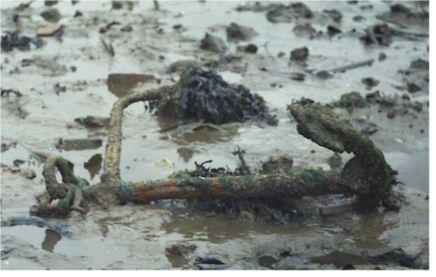
'ANTELOPE'
After reading ‘The Westcotts & their Times’ by Ian D. Merry about the wreck of the ‘Bertie’, but not looking to read where it was. I went out to the dismasted hulk lying off the Laira Embankment, and
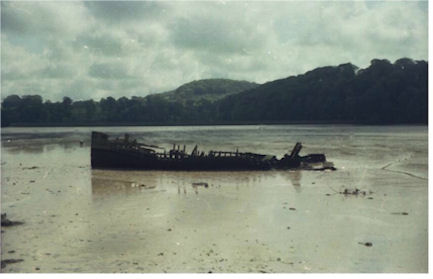
That very afternoon I phoned the Naval Base and spoke to the Harbour Master. He too said that he knew of the hulk but afraid it was just out of his area, and he didn’t know the name of it. But, as the librarian said, if I did find anything about her, please let him know.
I was getting a bit frustrated now. The more I couldn’t find the name, the more I was determined to find out. Later on I phoned up Ian Merry about the hulk. After looking up some of his old notes he phoned me back and said that she was called the ‘Antelope’. That is all he could tell me. That was all I needed. I was very happy now – now that I could put a name to this old dismasted wooden hulk. But then I started to think of how did she get there? When was she built? And where? Etc, etc.
The best place that I could think of for this information would be the Customs & Excise offices in Plymouth to see if she was registered there.
As luck would have it, she was. The ‘Antelope’ was a Brixham fishing ketch of 49•97 tons. She was built by Mr. R. Jackman of Brixham in 1906 and owned by a Mr. Richard Couch Elliott of Brixham for ten years, and then she was sold and transferred to Plymouth.
In Plymouth she had, in all, twelve owners being sold in 1925 for £250. In 1936 she had an old 1926 4-cylinder engine made by The Gas Plant of New York, U.S.A. fitted. She could do a top speed of 4½ knots. In 1952 she was converted to a houseboat, and as houseboats don’t have to register- the trail stopped there – for the moment.
HOOE LAKE
I went along to Hooe Lake to see what I could find there. The tide was in when I arrived but I could make out some remains of some old barges sticking out of the water. I knew there was a barge called the ‘Annie’. A big barge called ‘Arthur’ and two barges with the name of ‘Bertie’. One was owned by John Westcott of Plymouth and the other was from Faversham.
Looking out over the lake I could make out the big barge called ‘Arthur’ and further out I could just make out a smaller barge, which could be the ‘Annie’ that was built in 1899 by Frederick Hawke of Stonehouse.
Down in front of me there was two bow or sternposts standing out of the water. These posts could be the ‘Bertie’. I’ll have to go back when the tides out.
The next time the tide was out and was the two posts where sticking up looked like the remains of three hulks. I walked along the keel of the hulk on the left hand side and that is the one I think maybe, was the ‘Bertie’ that was once owned by the Westcotts of Plymouth. It was described as a barge with one mast. David Banks & Co built her in 1883. As I walked along it, it was like walking alone the backbone of a
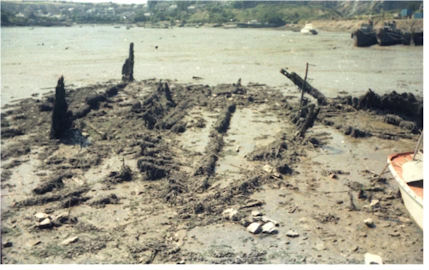
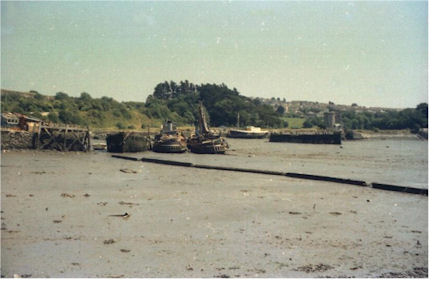
'Bertie, Tug (HL441828), Tug, & 'Arthur'.
The hulk on the far side with the sternpost leaning over to one side was still a mystery to me.
Along the north side of the lake were two old tugs and a big barge out from the wall sticking out into the lake.
I made my way round to the wall, and I managed to climb up on to the top.
The wall was two foot wide and it was a hard job making my way along the top as it had set along the top rocks and stones sticking up. At the end of the wall there was a timber plank from the wall to the barge.
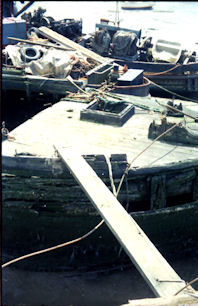
Going back to the ‘Berties’ I thought that the remains of the third hulk could be the ‘Annie’ that was built in 1899. If it is then what is the name of the remains that are lying over on the west side of the lake?
It was a few mouths later that I wrote to Martin Langley, who had written an article in a magazine about hulks in the West Country, who put me right with the hulks in Hooe Lake. We would correspond and exchange hulk notes for a further few years.
‘YMS 378’
I heard that there were remains of a large wooden vessel not far from where I worked, which was down Durnford Street, Stonehouse.
During one dinner break I went along down to Freeman’s Wharf to see her. She was lying along the
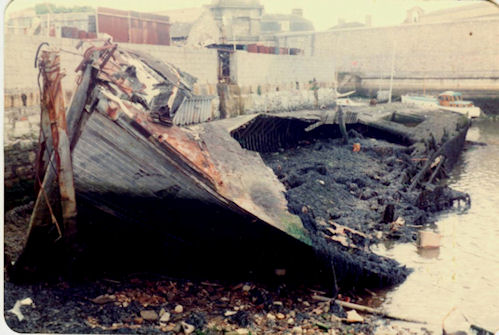
I spent a lot of time measuring and looking around this vessel as it was big and I could not figure out what sort of vessel she once was.
As I was writing a letter to the Queen’s Harbour Master about what I had found out about the ‘Antelope’, I thought I would ask if he knew about the YMS. When the reply came back he said he was sorry that he couldn’t throw any light on the matter.
I also wrote to the National Maritime Museum at Greenwich to see if they knew what the YMS stood for, but they wrote back to say that it may have meant ‘Yard Maintenance Service’ and it would be best if I were to get in touch with who ever is in charge of the Royal William Victualling Yard (as she is just outside), or the Queen’s Harbour Masters Office, or the Customs House.
I had already tried the Harbour Master so I tried the Victualling Yard by writing them a letter. I never got a reply. I tried the Customs House with no luck.
A few mouths later I was showing a photo album at a W.S.S. meeting, and one of the members stopped at the photo of the vessel and said that he may have same information about her. At the next meeting a mouth later this is what he come up with for YMS 378 – Yard Minesweeper 378. ‘Under the terms of Lend/Lease, the United States Navy had built for the hard pressed Royal Navy, escorts and minesweepers. Therefore, excluding the destroyer escort, only a relatively modest provision (100 frigates) was made for further escorts under the war programmes. Minesweeper construction, on the other hand, was on a large scale. To speed production and meet numerical requirements unity size was reduced to the minimum level, while to counter sophisticated influence mines a wood-hulled sweeper – the ubiquitous YMS – was later introduced and proved an outstanding success.
She was built at Green Port Base, Long Island, U.S.A. about 1944. She is 130 feet long by 24 feet beam. Main propulsion was direct diesel drive; with the engine coupled to the shaft through a single reduction gearing, and the exhausts were led either to a thin smoke pipe or a small and short funnel. They were fitted for both wire and LL sweeping; and were armed with a 3-inch A.A. gun on the fo’c’sle and two 20 mm A.A. guns on the bridge. 600 units were authorised to be built, and they proved very satisfactory small minesweepers.’
When I asked the scrapyard about the ships alongside their wharf they didn’t know anything about them. I wrote to there head office but they never replied.
About 12 months later I was talking to a gentleman down at the shipyard that was beside the YMS. He can remember her coming in and berthing along side the wharf. He said that it was about early 1950’s and they have taken all the metal parts off and just left the wooden hull to rot. He also said that the steel plating that is just out from the minesweeper is the remains of an old submarine.
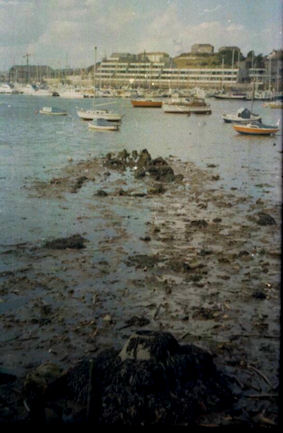
‘EDWIN’
This old frame of a Tamar Barge lies right at the end of Pomphlett Lake. I thought I would look along the sides off this lake to see if I could find any hulks and I was lucky. I went down and walked around it and
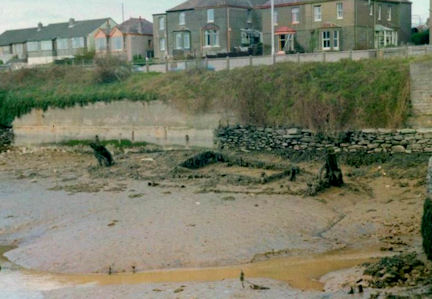
At home I looked though the list of Tamar Barges in ‘The Shipping & Trade of the River Tamer’. I made out a small list of barges 53ft long, or just over, e.g. ‘Edith’ – 54•9 ft, ‘Edwin’ 55•1 ft, - ‘Kate’ 56 ft, - ‘Lillie’ 55 ft and ‘PHE’ 55•8 ft.
Later on, I thought as this barge was in the Oreston area, I wondered if Mr. Fred Brown, who I was told was a mate on the Tamar Barges, would know anything about this hulk in Pomphlett Lake. I phoned Mr. Brown and he said that he would speak to his brother, who also was on the barges. A few days later Mr. Brown phoned me back and said that his brother remembers it as the ‘Edwin’ and he helped to break some of it up. I said that I had a list of five vessels that it could be and the ‘Edwin’ was on that list. So I was more than sure that it was the ‘Edwin’.
‘TRIUMPH’
The ‘Triumph’ was a lucky find. I was out at Poldrissick looking for the ‘Millom Castle’ and the ‘Lynher’. I stopped at the farm beside the River Lynher where the two I was looking for were. After asking the farmer's permission to go on his land and look at the hulks, I made my way across very thick mud then down a very a very slippery slope. I arrived along the riverbank. In a small inlet I found a rudder lying in the mud. You could also see a small part of the keel and the sternpost. I measured this very roughly and I made it 54 ft.
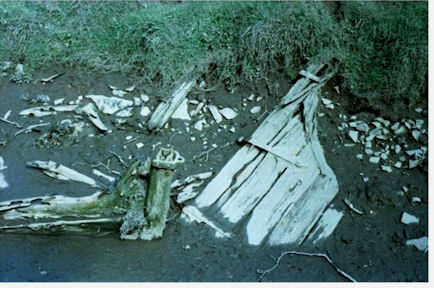
After talking to Mr. F. Brown and reading ‘The Shipping & Trade of the River Tamar’ I found that the hulk of the ‘Triumph’ is along the River Lynher. The ‘Triumph’ was 56 ft long, so this must be her.
‘TAP’
I found the ‘Tap’ while I was looking for the ‘Master Hand’.
She lies in the mud inside the Ballast Pond at Torpoint. You could see her from the road, but the best view of this hopper barge was to go along the top of the wall of the Ballast Pond. It is best to ask permission from the Sailing Club first.
I meet the owner of the barge working on an old London tug that was lying inside the Pond as well. I met
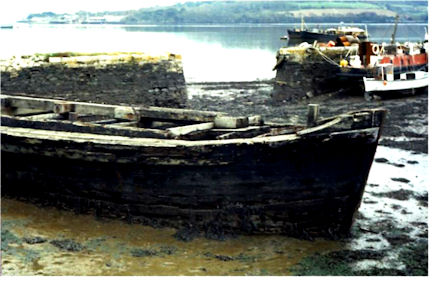
When I got back home I wrote to the Plymouth Ship’s Registrar and Mrs Prowse wrote back to say that the name ‘Tap’ was a hopper barge and was built in 1888. The registry was closed on the 27th May 1976 on the advice from the beneficial owner.
I meet the owner of the ‘Tap’ later on his tug and I showed him the letter from the Registrar and he was quite interested that I had found the date she had been built.
‘SALTASH’
This keel could be found in Tamerton Lake. I believe that this is the ‘Saltash'.
I was reading an account of the Tamar Barge ‘Saltash’. In the Monograph No 46 – 1980 from ‘The Shipping & Trade of the River Tamar’, Part 2, it describes the ‘Remains of the hulk can be seen near Forder (Saltash)’. But I found a keel in Tamerton Lake, and the ‘Saltash’, it is said, ended her days as a houseboat for Boy Scouts in Tamerton Lake. I could not see a hulk once used as a houseboat for the Boy Scouts sailing down Tamerton Lake then 3 miles to Forder and being beached there. So it could still be in the creek.
I thought, ‘Oh good. Walking distant from home.’ It was a case of everyone drop what you’re doing, ‘welly’ boots on, we’re going for a walk time.
As we walked along Station Road, which runs along side Tamerton Creek, we came first to the remains of the old quay. We stopped there and thought about the time in its hey day and tried to picture the scene of the quay with a barge along side unloading horse manure from Sutton Harbour or Devonport, to be transported in carts to the farms around Tamerton. Beside the quay there would have been boxes of strawberries to be loaded onto the barge and shipped back into Plymouth for the markets.
From there we walked further up the road and round the bend, looking down into the lakes edge. We noticed in the fence there was an old gateway. The path down to the waters edge was a bit over grown, but we all made it down and there was this long keel.
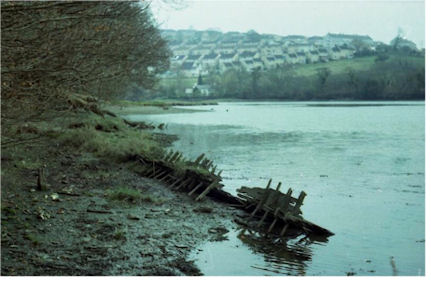
I put my findings to Mr. Ian D. Merry, who wrote the Monograph No 46, and he agreed that it is more likely that this is the ‘Saltash’ all though he has not seen the keel in Tamerton Lake. Mr. Merry said that he got the information from a very old gentleman who may have got the name wrong.
‘ELIZABETH JANE’ or the 'LORD JOHN ROBERTS'
This one is down in the book ‘The Shipping & Trade of the River Tamar’ as the ‘Saltash’. I don’t believe it is (see ‘Saltash’). As I knew there were some remains of a hull at Forder. I went down there and had a look. I was surprised at the size of the hulk and all I could do at the time was to take some photos of it. I could not measure it as half of it was in the water.
A later look at her revealed that she is well out of the water at low tide. I called at the Shipwrights House by Forder Bridge to ask if he knew the name of the barge, but he did not know. But he did say that if I went down to Antony Passage and ask there I meet be lucky. I went down to Antony Passage and called at a shipyard there – but no luck. Further down the road beside two old World War II U.S. Landing Craft, I stopped a gentleman getting into his car and asked him about the barge. He told me that his Aunt had owned the barge and she is now in Australia and the barge’s name is the ‘Elizabeth Jane’. She was used as a Boy Scout Houseboat for 2 years then it was just left.
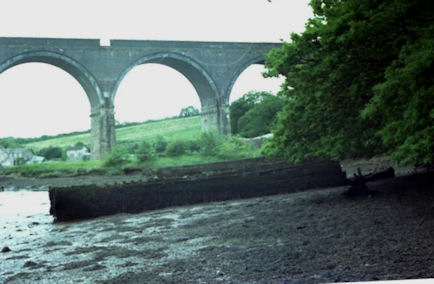
She was a barge of 50 tons and based in St. Germans.
‘MAGGIE ANNIE’
When I was looking for the ‘Millom Castle’ and the ‘Lynher’ at Poldrissick I was also looking for the ‘Maggie Annie’ as I knew she was down the Lynher River by an article in ‘The Shipping & Trade of the River Tamar’. I found the first two but not the ‘Maggie Annie’. So latter on I was talking to the farm owner and he said that there was another wreck farther down the river and he named a place beginning

‘CRUDEN BAY’
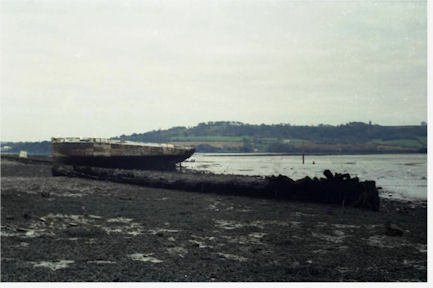
At home I looked up the name of Reynolds in the Phone Book and there was only one living at Torpoint. So I took a chance and phoned him up. So it so happened he was the owner and he said that it was an old wooden tug left there when he was a boy in 1920. His father put her there to take bits of to repair his other tugs. At first Mr. Reynolds called the old tug the ‘Lillyput’.
Later on he changed it to the ‘Cruden Bay’.
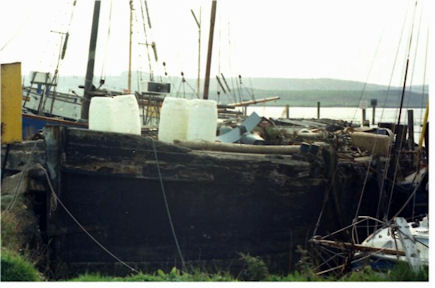
‘MASTER HAND’
Ian Wells (W.S.S.) sent me a paper cutting from ‘Maritime England News’ with an article about ‘Restore a Ship for 82’. It was about the sailing smack ‘Master Hand’, and the intention of restoring her. But was too much for one person to tackle. She had broken from her moorings in a gale and was grounded across a slipway. She has been lying like this for the past five years alongside the River Tamar near Torpoint.
So off I went to try to find her. I went across the Torpoint Ferry and turned left along Marine Drive. Looking over into the Ballast Pond I thought I had found her. But that turned out to be a hopper barge (see ‘Tap’). The owner of the barge said that if I were to go round into Timber Pond I might find her there. In Timber Pond there is no mistaking her as she has her name on her stern and bows. I was talking to a gentleman who had a tug up on the slipway that the ‘Master Hand’ was grounded across, and he said that he dragged her off, out of the way. But every high tide she would float around and was a danger to everyone there. So he put a hole in the bottom of her. So now when the tide comes in she is half submerged.
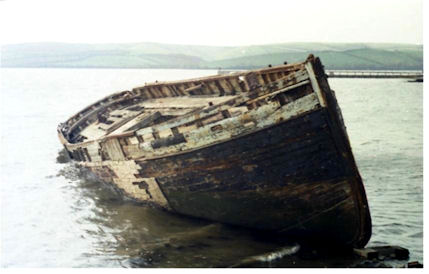
‘PATRINA’
I took the first photo just a few days after she had sunk in Sutton Pool just off The China House.
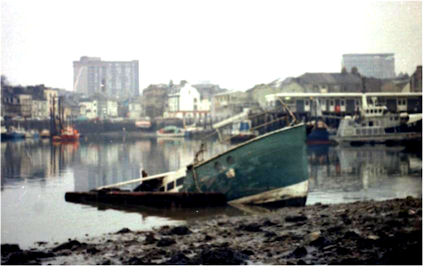
C.J.C. 1981/2